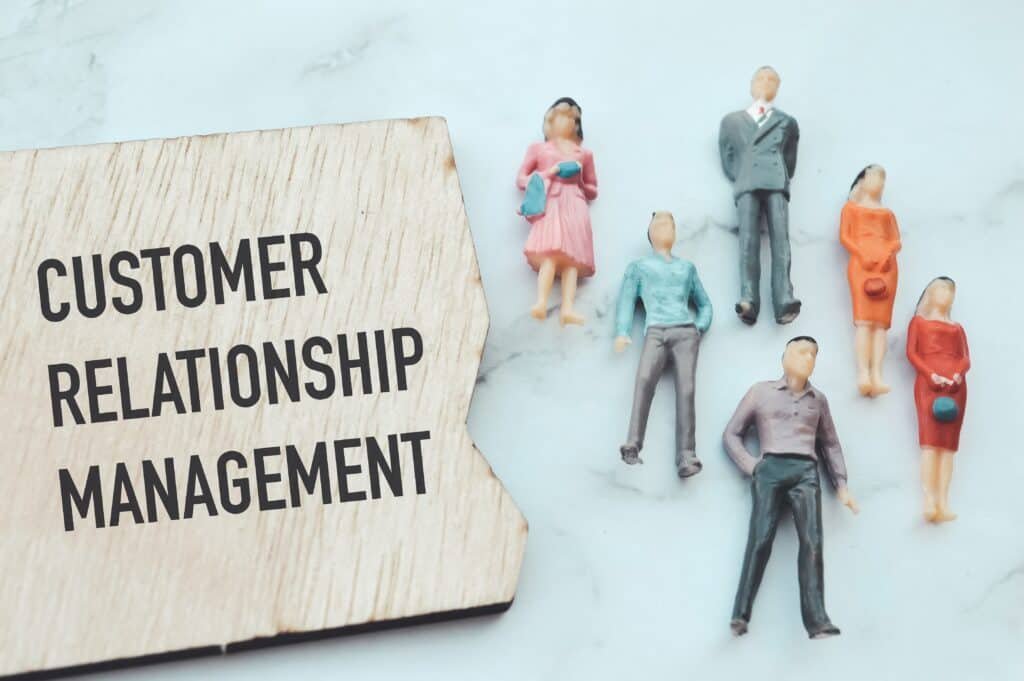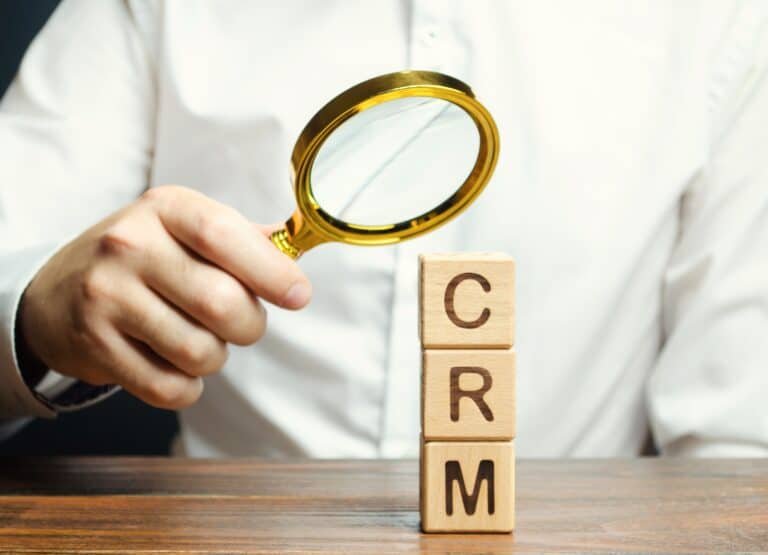
“Customer Relationship Marketing is an important customer service strategy that can help you generate customer loyalty, customer advocacy and increased customer lifetime value.”
Customer Relationship Marketing, or customer relationship management (CRM), manages customer interactions with a business. The customer relationship marketing strategy focuses on creating long-term relationships with customers through customer retention and satisfaction. This article will discuss what customer relationship marketing is, why businesses need to invest in CRM strategies, how to make your customer relationships more effectively, and some challenges that are faced by companies who use CRM strategies.
Jump Ahead To :
Customer Relationship Marketing Explained

Customer relationship marketing is a customer-centric approach that focuses on building and managing customer relationships over the long term. The goal of customer relationship marketing (CRM) is to create value for customers by targeting their needs and those of all stakeholders, such as employees and investors. CRM programs come in many shapes and sizes – from simple email campaigns or personalized website content to complex software suites featuring specialized modules aimed at specific market segments – but they share one thing: focus on customer experience.
A dedicated team that understands each customer’s unique requirements can help companies deliver more engaging experiences with every interaction across any channel. This includes online, offline, social media platforms like Facebook Messenger bots or even voice assistants Amazon Alexa or Google Home.
Customer lifetime value is a key metric in customer relationship marketing because it directly relates to how much revenue a business can expect from each customer. CRM also considers that customers differ in their needs and expectations – so the best approach varies across segments depending on what they’re looking for. For example:
– A BtoC company selling a high volume of goods online will have different requirements than an eCommerce store targeting consumers with lower, more frequent purchases or one who expects personalization at scales – such as fashion retailers offering custom style recommendations based on shoppers’ body type and social media updates. Data plays a crucial role in all these cases by enabling companies to understand customer behaviours over time better. That way, businesses can deliver more relevant customer experiences and deliver more value to each customer.
The customer relationship marketing approach is not new, but it’s becoming increasingly important as companies look for ways to differentiate themselves in an evolving customer landscape. Especially retailers are investing big money into their customer base because they know that customer lifetime value directly impacts the bottom line – and keeping customers happy is a good business sense too! According to a survey by Deloitte last year, 80% of retail CEOs expect maintaining strong brand loyalty among existing clients will be crucial for survival over the next five years. So enhancing customer experience conversations with chatbots or smart assistants like Amazon Alexa or Google Home makes perfect sense right now.
These technologies offer unique opportunities to enhance services beyond just product recommendations: personalized voice shopping experiences can become widespread soon; personalizing website content based on customer preferences and customer service conversations through messaging apps will likely become the new normal soon. But not all companies are taking advantage of these opportunities to build stronger customer relationships – yet!
Customer Relationship Marketing Strategies
This is an example of customer relationship marketing strategies. Customer Relationship Marketing Strategies are also known as CRM, and they are part of the bigger idea called Customer Relationship Management (CRM). Customer Relationship Marketing Strategies can be broken down into four main types: account-based, behaviour-based, lead generation based & product/service promotion-based.
Account-Based: this type focuses on individual customers or accounts you have with a company such as your bank, for instance. In this method, companies will focus their effort on building relationships with high-value clients to remain loyal to the business in question even when competitors try offering them better deals etc.
Behaviour-Based: This strategy takes place at a higher level than Account-Based by looking at customer behaviour in general and how they interact with the company. For example, Customer Relationship Marketing Strategies include looking at which websites a group of customers visit and what purchases these people make online. This type also considers when is the best time to approach an individual or group of individuals about products/services that you have on offer etc.
Lead Generation: In this strategy, companies take large amounts of information from their current clients (or potential ones), such as names & addresses, for instance). The idea here is to sell this data off to other businesses who can use it to reach out directly to their target audience via email marketing campaigns, for example.
Product / Service Promotions: These Customer Relationship Marketing Strategies focus on selling specific items through various methods (email, social media etc.). Customer Relationship Marketing Strategies is growing in popularity thanks to the fact that they allow businesses to build personal relationships with their customers, ultimately leading to increased sales.
Advantages Of Customer Relationship Marketing

Customer relationship marketing is the idea that building a good rapport with customers can be beneficial. Advantages of customer relationship marketing, such as improving sales and establishing loyalty, support this notion. Therefore many companies use one on one communication to engage their customers to stand out from competitors.
Benefits of Relationship Marketing includes;
– Allowing you to customize promotions and offers based on their interests, behaviours and preferences
– More engaged customers make it easier for companies to convert those visitors into paying customers. “Customers who receive personalized messages are 85 percent more likely than others to buy from the same brand again.” This means that not only do they have an increased chance of making repeat purchases but also refer new prospects, which can lead them down the road towards becoming repeat purchasers as well!
-“You will grow faster because you’ll be better at responding quickly.” You will become faster at responding to your customers, making them happier and thus encouraging repeat business.
– The cost of acquiring a new customer is five times higher than retaining an existing one. Advantages of customer relationship marketing also include the fact that it saves you money by increasing retention rates. Moreover, marketers can generate nearly three times as much revenue from each churned account because they can leverage what they know about those accounts through CRM systems.
-Referred visitors convert into buyers 83 percent more often.” Customer referrals have been shown time and again to be the most effective lead sources for any company; advantages of customer relationship marketing includes the fact that CRM systems make it possible to track referrals.
-If you retain just five percent more customers this year than last year, your business will automatically generate 50% more profits.” If you can increase retention rates by as little as five percent, your company can see a massive bump in their revenue! This is because the Advantages of customer relationship marketing include increased profitability through repeat purchases and word-of-mouth advertising.
– The average cost per sale for BtoB marketers who excel at lead generation is $331 vs $699 for those below average (Avantis). Customer relationship marketing means that there are huge savings to be made in the cost per sale department!
To increase customer relationship marketing, successful companies have been shown to invest heavily in CRM.
Disadvantages Of Customer Relationship Marketing
Integrating CRM into an organization’s workflow has gotten easier over the years. However, some companies still struggle with integrating their different software platforms to create a more cohesive unit that runs smoothly across all departments.”
Companies must show measurable evidence to justify future budgets spent.
So let’s have a look at some of the disadvantages of CRM.
-Unclear metrics of ROI
There is a lack of clear and accurate data for measuring returns on investments in CRM, leading to an underutilized budget due to overspending without the proper analytics backing it up.
To make sure that you are getting the most out of your CRM marketing strategy, there needs to be measured from multiple angles, including quantitative and qualitative results. Without these measurements, businesses will find themselves spending more money than they need because they don’t have any way of knowing what works best for their products or services. Companies must show measurable evidence to justify future budgets spent.”
Lack of integration with other systems
Integrating CRM into an organization’s workflow has gotten easier over the years. However, some companies still struggle with integrating their different software platforms to create a more cohesive unit that runs smoothly across all departments.”
Bad user experience
One of the biggest disadvantages of customer relationship marketing is its lack of use by younger generations because they prefer social media outlets like Facebook and Twitter for communication purposes. Many people under 30 have never used or even heard of foursquare, let alone OpenTable, which makes it difficult for those customers to engage on those services as well as other ones offered from businesses using them as part of their campaigns.”
Lacklustre results
It is important to note that CRM isn’t a silver bullet for success, and many companies have failed at using it due to a lack of accurate measurements. It takes time and trial-and-error to find out what works best with your business.”
The disparity between sales reps needs
As technologies develop over the years, customer relationship marketing has also evolved alongside them, which can cause disparity among sales departments when their goals don’t align together. For example, some sales teams need instant access. In contrast, others prefer scheduled reports because they work on other tasks throughout the day instead of monitoring data streams all day long like employees who work exclusively from computers do.”
How To Use Customer Relationship Marketing Wisely
Customer relationship marketing uses the power of social media to influence your customer behaviour and then grow a brand or product in an effective way that builds long term relationships with customers.
If you want to use Customer relationship management wisely, you need to understand how it works and when its strategies can add value to your business plan. It involves being open-minded towards new things, so they open up opportunities where traditional methods have failed. You should treat each individual as unique by understanding their needs and wants before making any offers that will help them and turn them into loyal supporters who are willing to buy more from you in the future.
For customer relationship management to be successful, you need a plan with a clear understanding of the values and expectations from each brand or product concerning their customers. Customer relationship marketing often starts with building awareness about your company and its products/services through various digital channels like social media platforms which will lead them to make an informed purchase decision in future.
– Customer Relationship Management Tools (CRM) help companies manage large volumes of data for effective communication with target markets by identifying patterns that can result in stronger relationships between businesses and clients who share similar interests. Therefore companies need to use Customer relationship marketing tools such as CRMs, Marketing automation software & Social Media Management tools to get their strategies right or else it will lead to customer frustration and low sales.
– Customer relationship marketing is more than just social media; businesses can benefit significantly by developing loyal customers on these platforms. Social media has become the dominant factor in influencing buying decisions over other channels like email or phone calls which used to be popular before the time of digital transformation where companies are using content marketing campaigns & search engine optimization (SEO) techniques for better online visibility with relevant audiences who have common interests etc.
– Customer Relationship Management software helps brands communicate more effectively with their customers through personal interactions at a scale that improves business performance. Marketers need to use advanced analytics tools and Customer Relationship Management Software that provides valuable insights into customer behaviour to help them create effective Customer Relationship Marketing strategies.
– Customer relationship marketing is all about building trust between the company and its customers by delivering what they expect in return for their loyalty, whether regular discounts or personalized offers depending on their interests. Customer relationship management helps businesses reach out to clients who are more likely to buy from you again than target new audiences with similar interests. Therefore, understanding your audience habits through data analytics & Customer Relationship Management software will improve ROI, leading to increased revenue generation over time.
– Customer relationship marketing involves many different aspects of digital transformation. Marketers need to be well versed with multiple technologies like social media platforms, search engine optimization (SEO), content marketing campaigns using relevant keywords.
Conclusion
So, what does customer relationship marketing mean for your company? It means that you will be looking at the bigger picture instead of focusing on getting new customers or making a sale. You’ll also need to make sure that all of your stakeholders are happy with how they’re treated; if they aren’t, it could affect sales in the long run. The key is to focus on building relationships over time while balancing the needs of all parties involved – employees, investors, and customers alike!






